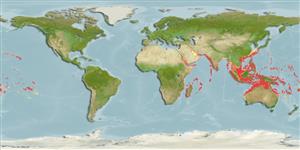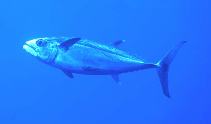Gymnosarda unicolor (Rüppell, 1836)
Dogtooth tuna
Adicionar sua observação em Fish Watcher
| Native range | All suitable habitat | Point map | Year 2050 |

|
| This map was computer-generated and has not yet been reviewed. |
| Gymnosarda unicolor AquaMaps Data sources: GBIF OBIS |
Carregue seu(sua) Fotos e vídeos
Pictures | Videos | Imagem do GoogleGymnosarda unicolor
Picture by Patzner, R.
Pictures | Videos | Imagem do GoogleGymnosarda unicolor
Picture by Patzner, R.
Maldives country information
Common names:
Dogtooth tuna, Thon à gros yeux, Worhimas
Occurrence: native
Salinity: marine
Abundance: | Ref:
Importance: | Ref:
Aquaculture: | Ref:
Regulations: | Ref:
Uses: no uses
Comments: Also Ref. 168, 5579.
National Checklist:
Country Information: https://www.cia.gov/library/publications/resources/the-world-factbook/geos/mv.html
National Fisheries Authority:
Occurrences: Occurrences Point map
Main Ref: Randall, J.E. and C. Anderson, 1993
National Database:
Occurrence: native
Salinity: marine
Abundance: | Ref:
Importance: | Ref:
Aquaculture: | Ref:
Regulations: | Ref:
Uses: no uses
Comments: Also Ref. 168, 5579.
National Checklist:
Country Information: https://www.cia.gov/library/publications/resources/the-world-factbook/geos/mv.html
National Fisheries Authority:
Occurrences: Occurrences Point map
Main Ref: Randall, J.E. and C. Anderson, 1993
National Database:
Common names from other countries
Classificação / Names Nomes comuns | Sinônimos | Catalog of Fishes(Gênero, Espécies) | ITIS | CoL | WoRMS | Cloffa
> Scombriformes (Mackerels) > Scombridae (Mackerels, tunas, bonitos) > Scombrinae
Etymology: Gymnosarda: Greek, gymnos = naked + Greek, sarde = sardine; 1598 (Ref. 45335).
More on author: Rüppell.
Etymology: Gymnosarda: Greek, gymnos = naked + Greek, sarde = sardine; 1598 (Ref. 45335).
More on author: Rüppell.
Environment: milieu / climate zone / depth range / distribution range Ecologia
marinhas associadas(os) a recifes; oceanódromo (Ref. 51243); intervalo de profundidade 0 - 250 m (Ref. 86942). Tropical; 20°C - 28°C (Ref. 5313); 31°N - 30°S, 32°E - 130°W (Ref. 168)
Distribuição Países | Áreas da FAO | Ecossistemas | Ocorrências | Point map | Introduções | Faunafri
Indo-Pacific: Red Sea and East Africa to French Polynesia, north to Japan, south to Australia.
Tamanho / Peso / Idade
Maturity: Lm ? range ? - ? cm
Max length : 248 cm FL macho/indeterminado; (Ref. 40637); common length : 190 cm NG macho/indeterminado; (Ref. 9710); peso máx. publicado: 131.0 kg (Ref. 168)
Max length : 248 cm FL macho/indeterminado; (Ref. 40637); common length : 190 cm NG macho/indeterminado; (Ref. 9710); peso máx. publicado: 131.0 kg (Ref. 168)
Descrição suscinta Chaves de identificação | Morfologia | Morfometria
Espinhos dorsais (total) : 13 - 15; Raios dorsais (total) : 12 - 14; Espinhos anais: 0; Raios anais : 12 - 13; Vértebras: 38. This species is distinguished by the following characters: body elongate and moderately compressed; mouth fairly large, upper jaw reaching to middle of eye; 14 to 31 large, conical teeth on upper jaw, 10 to 24 on lower jaw; 2 patches of villiform teeth on upper surface of tongue; total gill rakers on first gill arch 11-14; D1 XIII-XV, its border almost straight, the second followed by 6-7 finlets, dorsal fins close together; anal fin followed by 6 finlets; pectoral fins with 25-28 rays; interpelvic process large and single; lateral line strongly undulating; body naked posterior to corselet except for lateral line, dorsal-fin base, and caudal keel; caudal peduncle slender, with a well-developed lateral keel between 2 smaller keels on each side. Colour of back and upper sides brilliant blue-black, lower sides and belly silvery; no lines, spots or other markings on body; anterior tip of first dorsal fin dark; other fins greyish (Ref. 9684).
An offshore species found mainly around coral reefs. Generally solitary or occur in small schools of six or less. Preys on small schooling fishes such as Decapterus, Caesio, Nasio, Cirrhilabrus, Pterocaesio and squids. Caught mainly by pole-and-line. Marketed canned and frozen (Ref. 9684, 48637). Adults may be ciguatoxic (Ref. 37816). Minimum depth reported taken from Ref. 128797.
Ciclo de vida ou comportamento de acasalamento Maturidade | Reprodução | Desova | Ovos | Fecundidade | Larvas
Referência principal
Upload your references | Referências | Coordenador : Collette, Bruce B. | Colaboradores
Collette, B.B. and C.E. Nauen, 1983. FAO Species Catalogue. Vol. 2. Scombrids of the world. An annotated and illustrated catalogue of tunas, mackerels, bonitos and related species known to date. Rome: FAO. FAO Fish. Synop. 125(2):137 p. (Ref. 168)
Status na Lista Vermelha da UICN (Ref. 130435: Version 2024-2)
Segura ou pouco preocupante (LC) ; Date assessed: 01 March 2022
Uso pelos humanos
Pescarias: pouco comercial; peixe esportivo: sim
FAO(pescarias: produção; publication : search) | FishSource | Sea Around Us
Mais informação
Population dynamics
Parâmetros de crescimento
Max. ages / sizes
Length-weight rel.
Length-length rel.
Frequências de comprimento
Conversão de massa
Recrutamento
Abundância
Parâmetros de crescimento
Max. ages / sizes
Length-weight rel.
Length-length rel.
Frequências de comprimento
Conversão de massa
Recrutamento
Abundância
Life cycle
Reprodução
Maturidade
Fecundidade
Desova
Spawning aggregations
Ovos
Desenvolvimento dos ovos
Larvas
Dinâmica larval
Reprodução
Maturidade
Fecundidade
Desova
Spawning aggregations
Ovos
Desenvolvimento dos ovos
Larvas
Dinâmica larval
Physiology
Body composition
Nutrients
Consumo de oxigênio
Tipo de natação
Velocidade de natação
Visual pigments
Fish sound
Diseases & Parasites
Toxicity (LC50s)
Body composition
Nutrients
Consumo de oxigênio
Tipo de natação
Velocidade de natação
Visual pigments
Fish sound
Diseases & Parasites
Toxicity (LC50s)
Genetics
Genética
Heterozygosity
Hereditariedade
Genética
Heterozygosity
Hereditariedade
Human related
Aquaculture systems
Perfis para aquacultura
Estirpes
Ciguatera cases
Stamps, coins, misc.
Aquaculture systems
Perfis para aquacultura
Estirpes
Ciguatera cases
Stamps, coins, misc.
Ferramentas
Bio-Quiz | Livro eletrônico | Guia de campo | Chaves de identificação | Ferramenta auxiliar de frequências de comprimento | Ferramenta sobre a história de vida | Mapa de pontos | Classification Tree
| Catch-MSY |
Relatórios especiais
Checar Manutenção em Aquário | Checar Planilhas de Fatos sobre as Espécies | Checar Planilhas de Fatos sobre Aquicultura
Baixar XML
Fontes da internet
Aquatic Commons | BHL | Cloffa | Websites from users | Checar Observador de Peixes (FishWatcher) | CISTI | Catalog of Fishes(Gênero, Espécies) | DiscoverLife | ECOTOX | Faunafri | Fishtrace | GenBank(genoma, nucleotídeo) | GloBI | GOBASE | | Google Books | Google Scholar | Google | IGFA World Record | MitoFish | Bases de dados nacionais | Otolith Atlas of Taiwan Fishes | PubMed | Reef Life Survey | Scirus | SeaLifeBase | Árvore da vida | Wikipedia(Ir para, procura) | World Records Freshwater Fishing | Registro zoológico
Estimates based on models
Preferred temperature (Ref. 115969): 20.9 - 28.2, mean 26.5 (based on 938 cells).
Índice de diversidade filogenética (Ref. 82804): PD50 = 1.0000 [Uniqueness, from 0.5 = low to 2.0 = high].
Bayesian length-weight: a=0.01096 (0.00661 - 0.01818), b=3.06 (2.92 - 3.20), in cm Total Length, based on LWR estimates for this species & (Sub)family-body (Ref. 93245).
Nível Trófico (Ref. 69278): 4.5 ±0.75 se; based on food items.
Resiliência (Ref. 120179): Baixo, tempo mínimo de duplicação da população 4,5 - 14 anos (Assuming tmax>10).
Fishing Vulnerability (Ref. 59153): Very high vulnerability (90 of 100).
Climate Vulnerability (Ref. 125649): Very high vulnerability (92 of 100).




